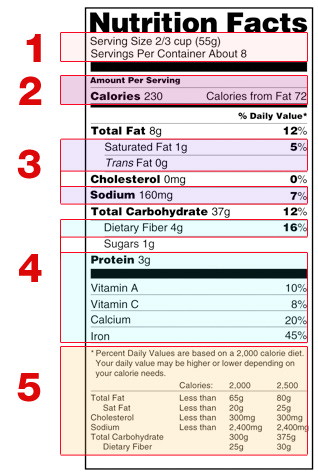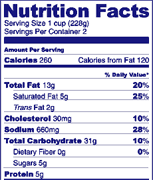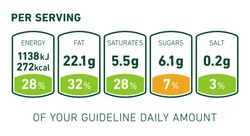45 how to interpret nutrition facts labels
How to Understand and Use the Nutrition Facts Label | FDA It's important to realize that all the nutrient amounts shown on the label, including the number of calories, refer to the size of the serving. Pay attention to the serving size, especially how ... How to Read the Nutrition Facts Label | Ohioline In Figure 1, the serving size listed is 2/3 cup and there are 230 calories per serving (2/3 cup) of the food. If a person only ate half a serving of the food (1/3 cup), they would only get half the calories and other nutrients listed on the label. If a person ate two servings of the food (1⅓ cup), they would get twice the calories and other ...
Nutrition Facts: How to Read Nutrition Labels - Greatist Here are some to look for: Calorie-free: Less than 5 calories per serving. Low calorie: 40 calories or less per serving. Reduced calorie/fat: At least 25 percent less calories/fat than the ...

How to interpret nutrition facts labels
How to Read the Nutrition Facts Label - Urogynecology ELLE: Those numbers with the percent symbols next to them represent the nutrient's "daily value" (DV). The percentage stands for what percent of your daily need for a nutrient is met by one serving of the food. The DV should only be used as a guide, since the percentages are based on a 2,000 calorie diet, and not everyone has the same ... PDF MOVE! Nutrition Handout N10: How to Read a Nutrition Facts Label size" is the official term used on food labels. Nutrition facts given on the food label are based on one serving. Be sure to look at the number of servings in the container. Even small containers may have more than one serving. If you eat the whole container, then you must multiply the nutrition values by the number of servings in the ... How to Read Nutrition Labels - Verywell Fit When you select foods, read Nutrition Facts labels to choose foods that provide protein. Lean meat products and low-fat dairy products are good examples. But when you check the nutrition label for protein, scan the fat grams to make sure the number is not too high. Many protein-rich foods are also high in saturated fat, and some foods in the ...
How to interpret nutrition facts labels. How To Read Food Labels - Fit Me Solution Food labels list the ingredients, the serving size, the number of kcalories provided, and the key nutrient quantities in a food—information consumers need to select foods that will help them meet their nutrition and health goals. Daily Values are a set of nutrient standards created by the FDA for use on food labels. How to read nutrition labels? A brief introduction to reading the Nutrition Facts label is provided below. Step 1: Begin by determining the serving size. Step 2: Determine the total number of calories consumed. Step 3: Use the Percent Daily Values as a Reference Point. Step 4: Review the Nutrition Glossary. 3 Ways to Read Nutrition Facts on Food Labels - wikiHow Protein is essential when it comes to promoting healthy muscle growth and maintaining a good energy level throughout your day. 9. Know that 5% of a daily value per serving is low and 20% is high. When it comes to nutrients, 5% or less is considered low and 20% or higher is considered high. How to Read Nutrition Facts Labels the Right Way - GoodRx Potassium. Calcium. Iron. Vitamin D. Most Americans do not consume enough of these nutrients, but they all can play a role in protecting your body from diseases, lowering your blood sugar, and improving your cholesterol levels. It's a good idea to choose foods that contain higher amounts of these nutrients.
Food Labels 101: Understanding the Nutrition Facts Label Nutrition labels can be a great tool for managing a heart healthy diet, which makes it very important that you understand what you're looking at when you read a label. Nutrition labels are based on a daily 2,000 calorie diet. Depending on your age, gender and activity level, you may need to consume more or less than 2,000 calories per day, so ... PDF How Do I Understand the "Nutrition Facts" Label? Nutrition Facts label and ingredient list. When you go grocery shopping, take time to read the Nutrition Facts labels on the foods you purchase. Compare the nutrients and calories in one food to those in another. The information may surprise you. Make sure you aren't buying foods high in calories, saturated fat, trans fat, sodium and added ... How to Use the Nutrition Fact Label, Eat Right, NHLBI, NIH When using the Nutrition Facts label as a guide, try these tips: Keep these low: saturated fats, trans fats, cholesterol, and sodium. Get enough of these: potassium, fiber, vitamins A and C, calcium, and iron. Use the Percent Daily Value (% DV) column when possible; 5% DV or less is low, 20% DV or more is high. Visit the Smart Food Shopping ... How to Read Nutrition Facts Label - Food Network When you take a look toward the top of the Nutrition Facts label you'll see the servings per container and the serving size. Pay close attention to the serving size. Pay close attention to the ...
Understanding Food Nutrition Labels | American Heart Association Remember that the information shown in the label is based on a diet of 2,000 calories a day. You may need less or more than 2,000 calories depending upon your age, gender, activity level, and whether you're trying to lose, gain or maintain your weight. When the Nutrition Facts label says a food contains "0 g" of trans fat, but includes ... The New Nutrition Facts Label | FDA The U.S. Food and Drug Administration (FDA) has updated the Nutrition Facts label on packaged foods and drinks. FDA is requiring changes to the Nutrition Facts label based on updated scientific ... The Basics of the Nutrition Facts Label Step 4: Check Out the Nutrition Terms. Low calorie: 40 calories or less per serving. Low cholesterol: 20 milligrams or less and 2 grams or less of saturated fat per serving. Reduced: At least 25% less of the specified nutrient or calories than the usual product. Good source of: Provides at least 10 to 19% of the Daily Value of a particular ... How to Read a Nutrition Facts Label - Everyday Health How to Read a Nutrition Facts Label. First, know that, as the label itself states, the included nutritional info is based on a 2,000-calorie-a-day diet. Your personal nutritional needs may vary ...
How To Read Food and Beverage Labels | National Institute on Aging At the top of the Nutrition Facts label, you will find the total number of servings in the container and the food or beverage's serving size. The serving size on the label is based on the amount of food that people may typically eat at one time and is not a recommendation of how much to eat. Read more about serving and portion sizes.
How to Read and Interpret Nutrition Labels - Cecelia Health September 22, 2021 by Cecelia Health. As part of keeping track of an overall balanced diet, the number one starting point is to read the nutrition label. Start with the portion size at the top of the label to determine what a portion size is. This helps keep track of optimal dietary intake. There may be more than one serving in a package.
Nutrition: How to Read a Nutrition Facts Label - familydoctor.org Men 50 years of age or younger should get at least 38 grams of fiber per day. Women 50 years of age or younger should get at least 25 grams of fiber per day. Fiber is found in fruits, vegetables, and whole grains. Look for the words "whole grain" on the package and ingredient list. Vitamins and minerals.

Pin by Brittney Casey on Nutrition & Fitness | Reading food labels, Nutrition labels, Nutrition ...
2019 Nutrition Facts Labels - LabelCalc This article will take a look at how to read the nutrition facts label and look at the updates that the FDA have put on the table for 2019 and beyond. ... In May of 2016 the FDA announced the new Nutrition Facts label and gave a compliance date of January 1, 2020 for food manufacturers with $10 million or more in annual sales and a compliance ...
How to Use the Nutrition Facts Label — Diet Doctor 3. Calculate net carbs per serving. Third, check the grams of dietary fiber per serving (circled in green, above). Subtract the fiber (green) from the total carbohydrates (blue) to get the net carbs. This chocolate has 9 grams of net carbs per serving (14g carbs - 5g fiber = 9g net carbs).
Learn How the Nutrition Facts Label Can Help You Improve Your Health That means if you consume 2,000 calories in a day, added sugars should account for no more than 200 calories. Read the Nutrition Facts labels on your packaged food and drinks to keep track of sugars, fats, protein, and other nutrients. Most sodium we consume is from salt, and salt is commonly in processed foods.
How To Read A Food Nutrition Label | Gobble Despite being important, this is one of the most confusing aspects of how to read food nutrition labels. For example, the USDA recommends that most people get 1,000 mg of calcium per day. So, if a serving of food contains 100 mg of calcium, this means the serving contains 10% Daily Value of calcium. The same applies to items on the food label ...
How To Understand Nutrition Facts Labels: A Guide To Food Labels - Nucific Now you just need to know how to decode food labels and what's most important. There are clues to a healthier life all over your food's nutrition facts labels.
How to Decode a Nutrition Label - Healthline People with eating disorders often find that nutrition labels trigger tendencies to obsess about calories, fat, or sugar. "When examined through the lens of food-preoccupation, as in chronic ...

blank food label | ... 46 (Nutrition) • Int Low Task 2: Interpret & Compare Food Labels | School ...
How to Read Nutrition Labels - Verywell Fit When you select foods, read Nutrition Facts labels to choose foods that provide protein. Lean meat products and low-fat dairy products are good examples. But when you check the nutrition label for protein, scan the fat grams to make sure the number is not too high. Many protein-rich foods are also high in saturated fat, and some foods in the ...
PDF MOVE! Nutrition Handout N10: How to Read a Nutrition Facts Label size" is the official term used on food labels. Nutrition facts given on the food label are based on one serving. Be sure to look at the number of servings in the container. Even small containers may have more than one serving. If you eat the whole container, then you must multiply the nutrition values by the number of servings in the ...
How to Read the Nutrition Facts Label - Urogynecology ELLE: Those numbers with the percent symbols next to them represent the nutrient's "daily value" (DV). The percentage stands for what percent of your daily need for a nutrient is met by one serving of the food. The DV should only be used as a guide, since the percentages are based on a 2,000 calorie diet, and not everyone has the same ...








Post a Comment for "45 how to interpret nutrition facts labels"